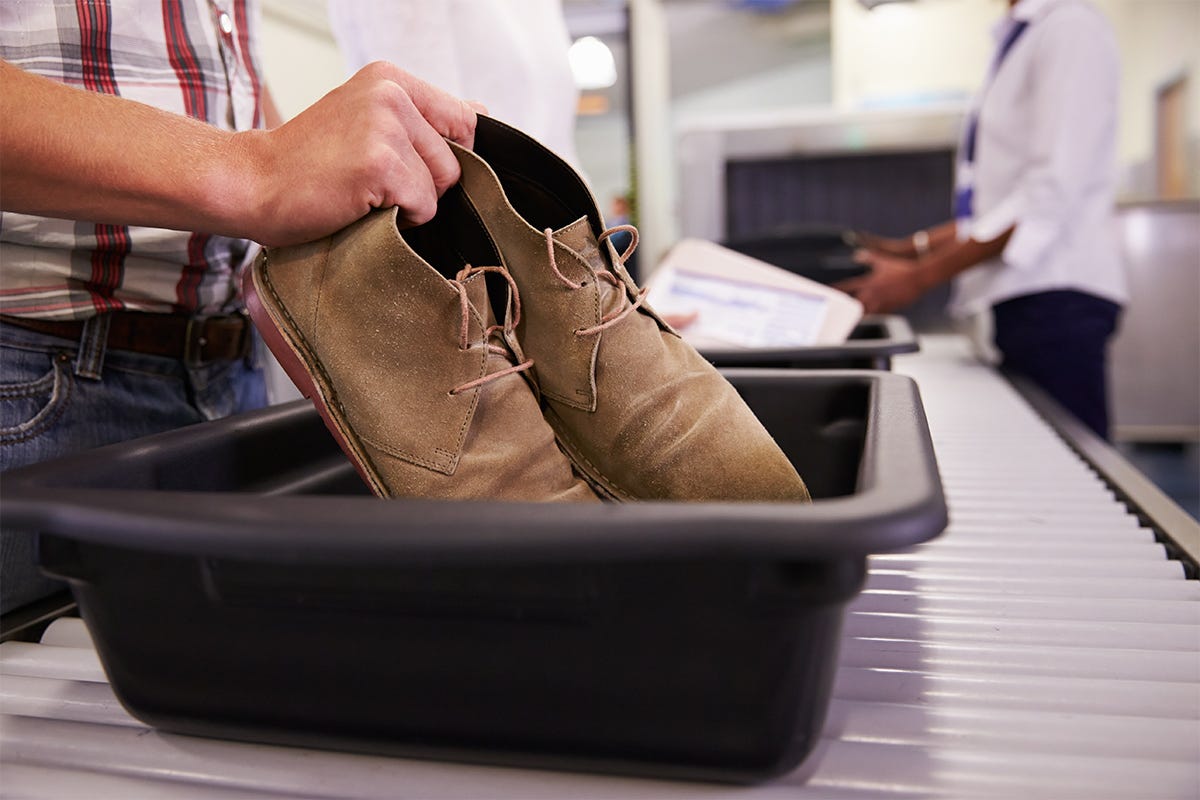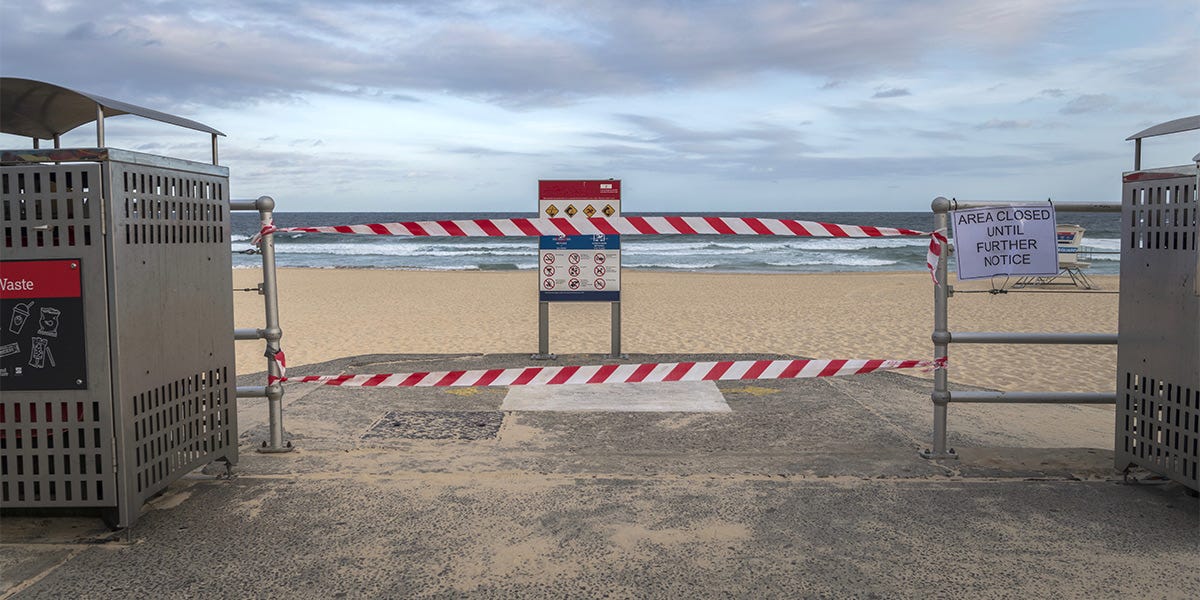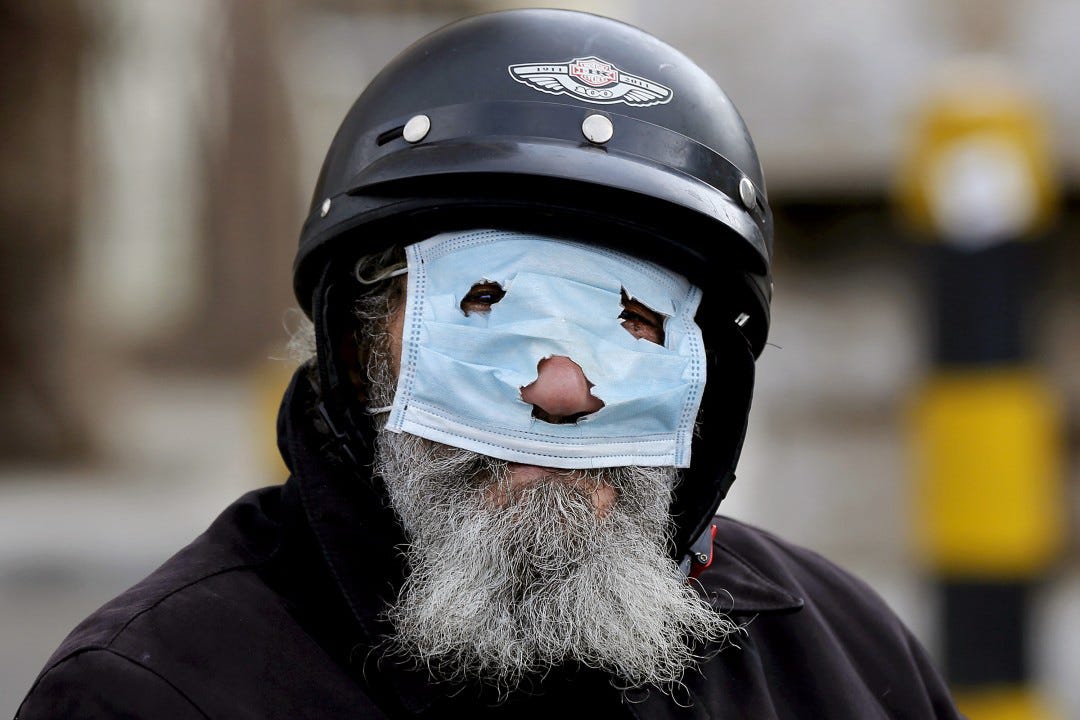Pandemic Theater
Good morning everyone,
For many people, Mother’s Day highlighted the emotional strains of social distancing. As our collective anxiety grows, you can expect governments and companies to step up their efforts to support people (or, more likely, the OPTICS of their efforts…).
—Edward

Illusion of safety
If you have flown on an airplane since 2001, you know the routine. Everyone settles into their seat and uses their smartphone until the pre-flight announcement declares, “all mobile devices must be turned off or switched to airplane mode for the duration of the flight, to avoid interference with the essential communication and navigation systems of the aircraft.” Flight attendants patrol the aisles, scolding passengers who try to sneak one last email. And yet, no one checks coat pockets, carry-on bags, or overhead compartments for phones that were never disabled. If “on” mobile devices are truly dangerous, then airline security procedures are woefully inadequate. If, on the other hand, using smartphones does not pose any danger, why are we stopping last-minute Facebook updates?
Air travel security includes many of these contradictory measures. The screening process prohibits passengers from carrying liquids, with the exception of medicine, baby food, or — more recently — disinfectant to prevent the spread of COVID-19. At the risk of stating the obvious, a person with nefarious intentions could easily disguise their liquid explosives as Benadryl, Pedialyte, or Lysol. And what about flying with peanut butter? Well, that depends on the discretion of the individual security agent. Passengers must remove their shoes when flying into the United States, but not for trips to Europe or Canada. Meanwhile, when undercover agents attempt to sneak real threats onto planes, they succeed “approximately 80% of the time.”
Airport security is not really about keeping passengers safe — it’s about making people feel safe. When you layer regulations on top of regulations, you often end up with “Security Theater,” a term coined by Bruce Schneier in his book Beyond Fear. Policies implemented with good intentions can easily turn into a system that not only increases complexity and cost, but also reduces the likelihood of achieving the original goal.
I was reminded of this concept during my most recent airport experience. In mid-March, my daughter was visiting her grandparents in Canada, and I went to pick her up before any COVID-related restrictions would prevent our travels.
In the airport, the restaurants remained open — but only to serve “takeout.” Think about what takeout looks like at an airport. People crowd around the front of the restaurants to order and collect their food, before finding a seat and eating their meal on their laps. The whole process is messy and uncomfortable. Plus, by removing the restaurants’ dine-in sections, you increase the density of people in the rest of the terminal — the exact opposite of effective social distancing.
A “takeout-only” policy at airport restaurants was conceived with good intentions but designed without coherent logic. The regulations did not increase safety; they might have actually endangered people. But, the new procedures conveyed the appearance of CARING about safety.
Over the last couple of months, we’ve seen lots of pandemic responses that mirror the “takeout-at-airport” situation. Welcome to the age of pandemic theater.
Bottleneck beaches

Without question, people’s lives have been radically disrupted by stay-at-home restrictions and commercial lockdowns. We can all appreciate the desire to reopen public spaces or relax certain guidelines. Experts, governments, and citizens are increasingly debating the question of “should we reopen, or is it too soon?” Political opinions vary, as does the science; we do not have a medical consensus on which plan is “best.” In last week’s post, I explained how fast feedback impacts people’s decision-making processes.
Let’s take a look at beaches, perhaps the most iconic site for differences in COVID-19 opinions. Back on April 18, Florida Governor Ron DeSanti authorized the reopening of some state beaches.
If you wanted to balance beach access with public safety, you would design guidelines that spread people as far apart as possible. Many localities enacted rules to reduce proximity and density:
No sitting allowed (people must remain in motion by walking, biking, running, swimming, etc.).
People must practice social distancing.
No gatherings of more than 50 people.
For managing large crowds, events often use tickets with time-specific entry (think of museums, theme parks, golf courses, etc.). These guidelines spread visitors over the course of a day, instead of the normal peaks and valleys you would expect with unmanaged consumer behavior. In the case of Florida, you could impose rules like “people with zip codes ending in even numbers can access beaches on Monday and Wednesday” or “non-Florida residents can access beaches between 1:00 and 3:00 pm.”
The WORST idea? Limit beach access to shorter-than-normal hours AND skip any kind of time-specific entry plans. Unfortunately (for public safety), many municipalities went ahead with this type of strategy. For example, Duval County allowed people to walk the beaches from 6:00 to 11:00 am and again from 5:00 to 8:00 pm. That plan not only leaves the beaches empty for most of the day, but also crams everyone together during the available hours.
How and why would anyone have designed this peculiar plan for beach access? Certainly not because someone evaluated the costs and benefits of various options. The more likely explanation comes down to politics. Different groups argued for “reopen now” and “keep them closed”; the two sides reached a compromise by limiting the hours for beach access. During these types of debates, people can easily hyper-focus on their own agenda while losing sight of the ultimate goal — limiting the spread of the virus while minimizing disruption in the community.
We currently live in a world of trade-offs with no “good” answers. If we maintain the lockdown, the economy suffers (and individuals suffer, too — some people could die as supply chains break down and food costs skyrocket). In contrast, if we reopen society, individuals will suffer with greater numbers of COVID-related deaths and illnesses (AND the economy suffers, too — soaring healthcare costs could impact citizens, companies, and governments).
To effectively manage an extreme situation like a pandemic outbreak, we need (1) rapid collection of information and (2) prudent analysis of relative trade-offs. Alas, neither political leaders nor the general public have ever excelled at weighing the pros and cons of a complex problem (see: “security theater” at airports).
We can only hope that the enormity of the COVID-19 crisis will spark greater contemplation of the choices we face. So far, I am not optimistic. As one example of a “why?!” decision, the US military has decided to disqualify enlisting recruits who have contracted — and RECOVERED — from COVID-19. (For context, researchers are not 100% confident that recovering from COVID-19 provides people with immunity, although the science is definitely leaning that way. But I have not seen ANYTHING that explains why a person who survived the virus should be permanently barred from military service).
Marketing theater

In Bryan Caplan’s excellent book, The Myth of the Rational Voter, he demonstrates that politicians make BETTER decisions than what you expect if they simply followed the will of the electorate. While we can mock the decisions that led to people packing Florida beaches or eating dinner on airport floors, many choices cannot be blamed on the government.
Take, for example, this phenomenon taking place across America (I hope someone takes a photo):

In theory, companies should deal with crisis situations more effectively than government departments. Why? Think about how CEOs are incentivized. They derive the majority of their income from stock options. From a purely financial perspective, every CEO should want their company to operate as efficiently as possible; that goal would also motivate the elimination of any “performance theater.” And yet, the primary thesis of the Marketing BS newsletter stresses that many companies — especially in the marketing department — rely on the illusion of success.
“Marketing theatre” begins at the very top of a company’s organizational chart. During the regular one-on-one meetings between the CMO and CEO, the conversation usually includes an update on the metrics: How many leads did we generate? What was the conversion rate? What channels are growing? Really, though, a CEO could review that information on the daily dashboard. The CMO’s value rests in their ability to provide insight that explains the “whys” behind the tables and numbers.
The second, more interesting, part of the meeting focuses on the “initiatives” — the tactics that a CMO and her team can use to improve their success rate in the future. In most cases, a CMO should present initiatives that could be described in the following types of ways:
Iterate on ad copy to increase CTR by 0.2%.
Expand A/B testing platform to third-tier portions of the website.
Determine why hot transfer rate is “only” 92% and understand trade-offs that could increase the rate to 93%.
Hire a high-quality content writer as part of redundancy planning.
Design a test to measure incrementality of the re-targeting program.
And therein lies the problem. While many of these actions could add real value to the business, they are not that exciting to talk about (let alone implement). So, many CMOs develop “sexier” initiatives to share with the CEO:
Project Chancellor to reach 2 million Facebook likes.
Project Festival to move to Web 3.0.
Project Masquerade to integrate the CRM system with the Martech stack.
Project Upgrade to motivate all employees to share content on their personal social media.
Project Menagerie to add personalization to all email communication.
Sometimes the sexy projects can add real value — in the same way that sometimes governments need to open beaches. Too often, though, the emphasis on sexiness supersedes the importance of the goal. When this happens, we end up with initiatives that are fun to talk about, but deliver a highly inefficient return on the (superfluous) resources they receive. In other words, we find ourselves wrapped up in “Marketing Theater.”
In previous newsletters, I have argued that the problem of “Marketing BS” is driven by the reality that CMOs get their next job based on the scale of their budget and the size of their team. This path to career advancement provides marketers with a strong incentive to focus on size, rather than effectiveness. Bottom line: “marketing theater” begets more “marketing theater.”
How do we fix this situation?

Over the last month, politicians of all stripes have capitalized on pandemic panic to advocate for the very same causes they wanted long before COVID-19.
On Twitter, Biotech expert Balaji Srinivasan outlined the benefits for those on both the right and the left:


On April 29, David Goldhill (Sesame CEO and healthcare policy analyst) posted a Medium article discussing the complexity of the COVID crisis:
While quarantines of the infected have long been an effective means of impeding disease, shutting down the healthy — and the global economy — at this scale is utterly unprecedented. It is the equivalent of prescribing to the entire population a highly toxic untested drug with massive side effects. Epidemiologists know viruses, but have no special expertise in agriculture, supply chains, labor markets, fiscal policy, social fabric, mental health, education, family relations, national security, or any of the many other areas of their patient’s life disrupted by their recommended shutdown.
Goldhill’s conclusion is clear:
So, what should our public health experts do to treat the patient and not just the virus? First, they can encourage us to maintain the many social distancing techniques short of suppression that individuals and communities can use to reduce transmission. Second, as our knowledge of this virus and its transmission evolves, they can be creative about finding more targeted mitigation approaches. This requires opening up debate on alternatives with an eye to finding acceptable trade-offs, rather than discouraging disagreement in the cause of solidarity.
I think Goldhill is right. We need to understand the relative risks for any possible decision; moreover, we need to evaluate the trade-offs for any action, instead of treating all choices as binary. Researchers continue to warn that finding an effective treatment or vaccine might take five years (or longer!). If we must live with this virus for extended periods of time, we will not have the luxury of “pandemic theater.”
Taking off our shoes at the airport is a minor inconvenience, but what if governments asked (or ordered) people to give up their footwear permanently? You would hope that someone would use data to calculate the benefits and costs for such a plan, rather than simply creating a rule to make people “feel” a greater sense of safety and security.
Keep it simple and stay safe,
Edward
If you are enjoying Marketing BS, the best thing you can do is share it with friends and recommend they subscribe. The next best thing you can do is comment on this piece or click the heart (which makes this article more visible for other readers).
Edward Nevraumont is a Senior Advisor with Warburg Pincus. The former CMO of General Assembly and A Place for Mom, Edward previously worked at Expedia and McKinsey & Company. For more information, including details about his latest book, check out Marketing BS.




